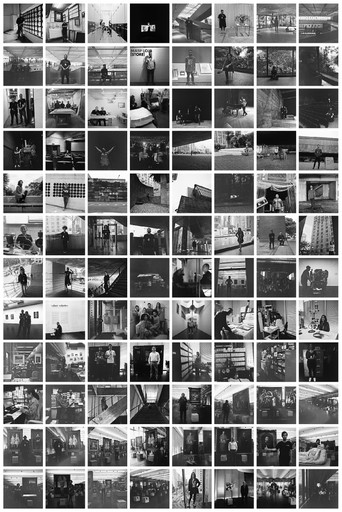Convidada pela curadoria do MASP, realizei uma série fotográfica em homenagem aos 50 anos do edifício de Lina Bo Bardi na Avenida Paulista. Convidei a todes que trabalhavam no museu para que escolhessem lugares de relevância pessoal e profissional no edifício onde quisessem ser fotografades. Também convidei a todes que gravassem um depoimento em áudio (em colaboração com Nico Espinoza) descrevendo como imaginavam os seus retratos e o porquê do lugar escolhido. Colaboraram no total 139 trabalhadores. Este projeto é uma homenagem aos 50 anos do edifício e um salve a todes que fazem parte dessa história, eu e minha família também. O projeto completo é composto de fotografias, texto e uma instalação audiovisual com multicanais de áudio.
Invited by the MASP curators, I made a photographic series in honor of the 50 years of Lina Bo Bardi’s building on Paulista Avenue. I invited everyone who worked at the museum to choose places of personal and professional relevance in the building where they wanted to be photographed. I also invited everyone to record an audio statement (in collaboration with Nico Espinoza) describing how they imagined their portraits and why they chose the place. A total of 139 employees collaborated. This project is a tribute to the 50 years of the building and a salute to everyone who is part of this history, me and my family as well. The complete project is composed of photographs, text, and an audiovisual installation with multi-channel audio.
O prédio de meia-idade, meio século. Nem faz tanto tempo assim. O desmanche do antigo belvedere, ainda vivo na lembrança das crianças de ontem, e o levante da caixa flutuante. O índice e o ícone. O monumento carrega a história que parte do povo rapidamente esqueceu. A escada em L na arquitetura moderna, com vocação a púlpito. Dela se vê o vão magistral, intervalo pulsante entre avenida e infinitos edifícios, onde repousa a pedra. O fluxo, as pessoas, os burburinhos e a pedra. Um monolito insólito, improvável, silhueta gorda, testemunha vertical de um sem fim de coisas. Com pedrinhas ao redor que parecem presentes de natal. O vão palco, cenário, plateia das frequências ritmadas que fazem da laje um lençol. Estrutura dinâmica que abriga esquerdas e direitas.
Dos registros de sua construção, homens, sempre eles, devidamente identificados, até aqueles que mal se veem as canelas. Já a mulher de corpo inteiro no canteiro da obra, anônima. A exceção é a Dona Lina, que mesmo assim se chamava e era chamada de “o arquiteto”.
O belvedere é o vão. 50 anos depois. Muitas pessoas que não participaram dos fatos não se sentem parte da história. Dentro e fora do museu, personagens e ameaças se repetem, ou quem sabe nunca saíram daqui. Mais um golpe, velho discurso de ódio. O prédio de colunas vermelhas deve ser chamado de comunista outra vez. A pedra amanheceu pixada com uma foice e um martelo. Ela e as paredes daqui certamente se lembram do que parte do povo rapidamente se esqueceu. Povo que desce na estação Trianon sem notar que ali é o lugar para onde a Dona Lina queria que o povo fosse.
Arquitetura para abrigar e fabricar história. Corpo presente no espaço da cidade. Monumento quer dizer advertência! Monumentalidade como coletividade, disse o engenheiro Suzuki após Lina Bo Bardi. Corpo vibrante de concreto, vidro, obras de arte e gente, muita gente.
A pedra repousa na palma da mão da arquiteta. Tal fotografia indica a porta do banheiro das funcionárias e vigia o corredor estreito. A intensidade da mirada da autora daquele lugar é uma presença penetrante que transcende tempos e materialidades. Ainda bem, porque o anacronismo é grande. 50 anos que vão e vêm numa velocidade estrondosa.
The middle-aged building, half-century. Not that long ago. The dismantling of the old belvedere, still alive in the memory of the children of yesterday, and the raising of the floating box. The index and the icon. The monument carries the history that part of the people quickly forgot. The L staircase in modern architecture, with pulpit vocation. From it, we can see the masterly span, a pulsating interval between avenue and infinite buildings, where the stone rests. The flow, the people, the buzz, and the stone. An unusual monolith, improbable, fat silhouette, a vertical witness to an endless number of things. With little stones around that look like Christmas presents. The vain stage, scenery, audience of the rhythmic frequencies that make the slab a sheet. Dynamic structure that shelters lefts and rights.
From the registers of its construction, men, always, duly identified, to those who barely see the shins. The full-body woman on the construction site, anonymous. The exception is Dona Lina, who even so was called "the architect".
The belvedere is the free span. 50 years later. Many people who did not participate in the events do not feel part of the story. Inside and outside the museum, characters and threats are repeated, or who knows never left here. One more blow, old hate speech. The red column building must be called communist again. The stone dawned spraypainted with a scythe and a hammer. It and the walls here certainly remember what part of the people quickly forgot. People coming down at Trianon station without noticing that this is the place where Dona Lina wanted the people to go.
Architecture to house and fabricate history. Body present in the city space. Monument means warning! Monumentality as a collective, said engineer Suzuki after Lina Bo Bardi. Vibrant body of concrete, glass, works of art and people, many people.
The stone rests in the palm of the architect's hand. Such a photograph indicates the bathroom door of the employees and watches the narrow corridor. The intensity of the author's gaze of that place is a penetrating presence that transcends time and materialities. Good, because the anachronism is great. 50 years that come and go at a thunderous speed.





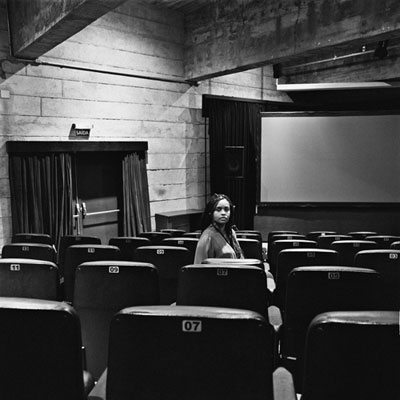

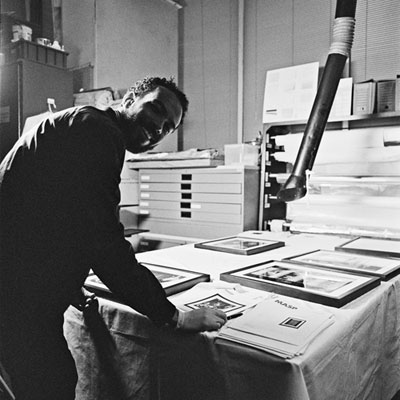
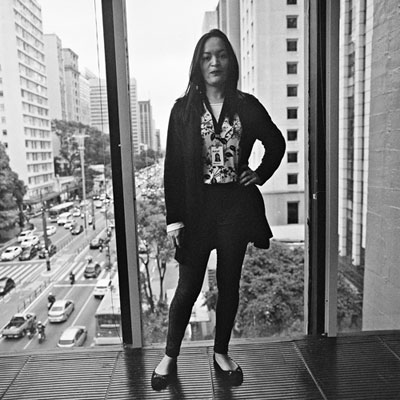

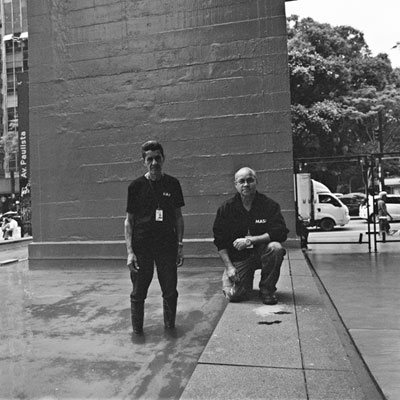
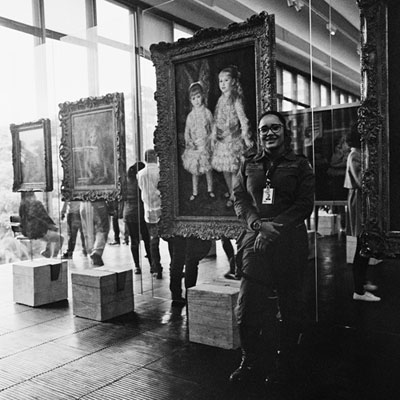
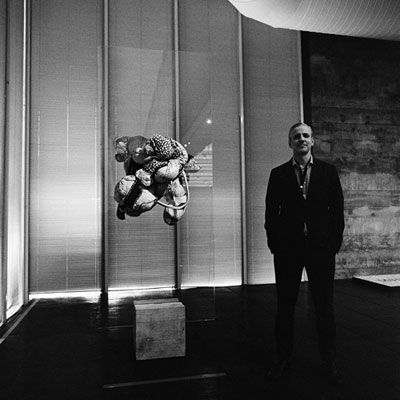



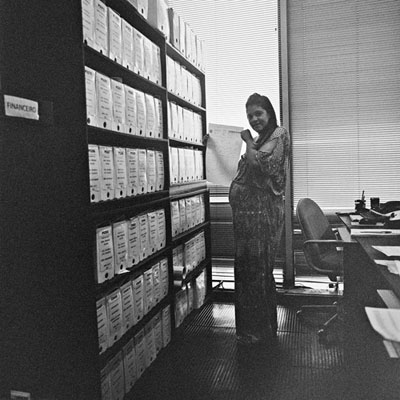
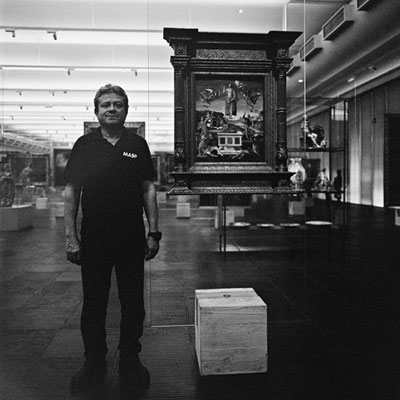

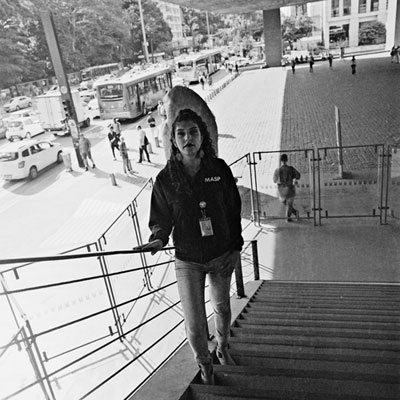

ISBN : 9788531000737
Organização [Edited by] Adriano Pedrosa com a assistência de [with the assistance of] Guilherme Giufrida Textos [Texts by] Adriano Pedrosa; Annette Svaneklink Jakobsen; Barry Bergdoll; Eduardo Pierrotti Rossetti; Guilherme Giufrida; Guilherme Wisnik; Lina Bo Bardi; Marcelo Ferraz, Marcelo Suzuki, Roberto Rochlitz; Marina Grinover; Olivia de Oliveira; Renato Anelli; Sarah Feldman; Silvana Rubino; Silvio Oksman, Lúcia A. Furlan, Luiza Nadalutti, Heloísa Maringoni, Juca Pires; Zeuler R. M. de A. Lima Ensaios visuais [Photo-essays by] Lucia Guanaes; Luiza Baldan (96 img.); Nair Benedicto Edição bilíngue português/inglês [Portuguese/English bilingual edition] Publicado por [Published by] MASP, Museu de Arte de São Paulo Assis Chateaubriand
Video 4'59"
Captação de áudio e composição Audio recording and composition Nico Espinoza
Montagem Editing Analu Cunha
